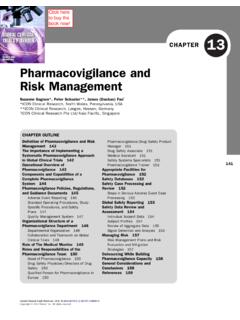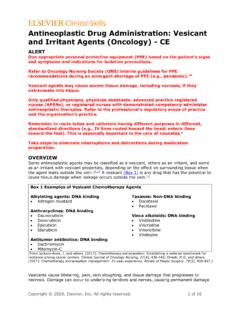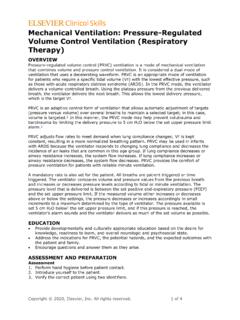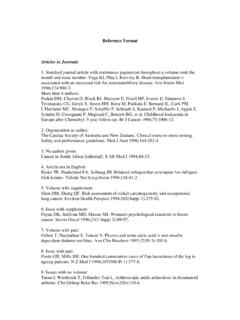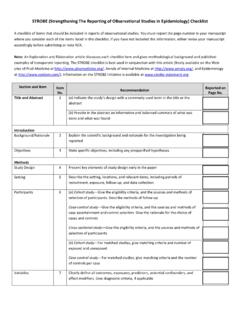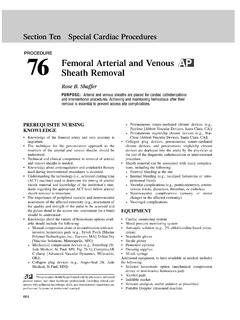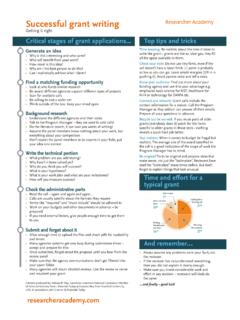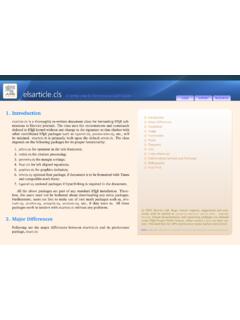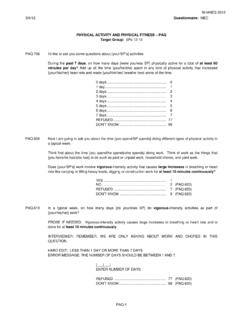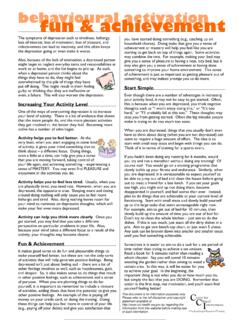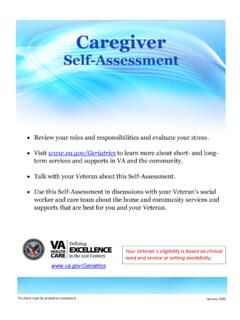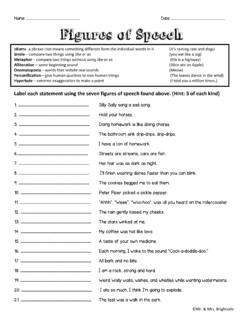Transcription of Deconditioning - Elsevier
1 Deconditioning Deconditioning refers to the changes in the body that occur during a period of inactivity. The changes happen in the heart, lungs, and muscles. They make you feel tired and weak (fatigued) and decrease your ability to be active. The three stages of Deconditioning include: Mild Deconditioning . This is a change in your ability to do your usual exercise activities, such as running, biking, or swimming. Moderate Deconditioning . This is a change in your ability to do normal everyday activities, such as walking, shopping for groceries, and doing chores. Severe Deconditioning .
2 In this stage, you may not be able to do minimal activity or usual self-care. What are the causes? Deconditioning can occur after only a few days of inactivity. The longer the period of inactivity, the more severe the Deconditioning will be, and the longer it will take to return to your previous level of functioning. Deconditioning is often caused by inactivity due to: Illnesses, such as cancer, stroke, heart attack, fibromyalgia, and chronic fatigue syndrome. Injuries, especially back injuries, broken bones, and injuries to soft tissues, such as ligaments and tendons.
3 A long stay in the hospital. Pregnancy, especially if long periods of bed rest are needed. What increases the risk? The following factors may make you more likely to develop this condition: Staying in the hospital or being on bed rest. Obesity. Poor nutrition. Being an older adult. Having an injury or illness that affects your movement and activity. What are the signs or symptoms? Symptoms of this condition include: Weakness and tiredness. Shortness of breath with minor physical effort (exertion). A heartbeat that is faster than normal. You may not notice this without taking your pulse.
4 Pain or discomfort with activity. Decreased strength, endurance, and balance. Difficulty doing your usual forms of exercise. Difficulty doing activities of daily living, such as grocery shopping or chores. You may also have problems walking around the house and doing basic self-care, such as getting to the bathroom, preparing meals, or doing laundry. How is this diagnosed? This condition is diagnosed based on your medical history and a physical exam. During the physical exam, your health care provider will check for signs of Deconditioning , such as: Decreased size of muscles.
5 Decreased strength. Trouble with balance. Shortness of breath or a heart rate that is faster than normal after minor exertion. How is this treated? Treatment for this condition involves an exercise program in which activity is increased slowly. Your health care provider will tell you which exercises are right for you. The exercise program will likely include: Aerobic exercise. This type of exercise helps improve the functioning of the heart, lungs, and muscles. Strength training. This type of exercise helps increase muscle size and strength. Both of these types of exercise will improve your endurance.
6 You may be referred to a physical therapist who can create a safe strengthening program for you to follow. Follow these instructions at home: Eating and drinking Eat a healthy, well-balanced diet. This includes: o Proteins, such as lean meats and fish, to build muscles. o Fresh fruits and vegetables. o Carbohydrates, such as whole grains, to boost energy. Drink enough fluid to keep your urine pale yellow. Activity Follow the exercise program that is recommended by your health care provider or physical therapist. Do not increase your exercise any faster than directed.
7 General instructions Take over-the-counter and prescription medicines only as told by your health care provider. Do not use any products that contain nicotine or tobacco, such as cigarettes, e-cigarettes, and chewing tobacco. If you need help quitting, ask your health care provider. Keep all follow-up visits as told by your health care provider. This is important. Contact a health care provider if: You are not able to do the recommended exercise program. You are becoming more and more tired and weak. You become light-headed when rising to a sitting or standing position.
8 Your level of endurance decreases after it has improved. Get help right away if: Have chest pain. Are very short of breath. Have any episodes of fainting. Summary Deconditioning refers to the changes in the body that occur during a period of inactivity. Deconditioning happens in the heart, lungs, and muscles. The changes make you feel tired and weak and decrease your ability to be active. Treatment for Deconditioning involves an exercise program in which activity is increased slowly. This information is not intended to replace advice given to you by your health care provider.
9 Make sure you discuss any questions you have with your health care provider. Document Released: 05/04/2015 Document Revised: 05/14/2020 Document Reviewed: 05/14/2020 Elsevier Patient Education 2020 Elsevier Inc.
